City Lore
City Lore, New York's center for urban folk culture, founded in 1985, is the first organization in the United States devoted expressly to the "documentation, preservation, and presentation of urban folk culture."[1]


With a mission to foster New York City – and America’s – living cultural heritage through education and public programs, City Lore encompasses a Lower East Side gallery space, performances, lectures, the People's Hall of Fame, a POEMobile that projects poems onto walls and buildings, and education programs throughout the five boroughs. City Lore documents, presents, and advocates for New York City’s grassroots cultures to ensure their living legacy in stories and histories, places and traditions. The organization also works with a wide range of partners to develop exhibitions, publications, and documentary films, and to advocate for the rights of street performers, ethnic clubs, and other grassroots cultural expressions in New York City. Described as “wise renegades” by Sonnet Takahisa, the group has also been described as a “practical application of a utopian endeavor” by the writer Marc Kaminsky. In a March 21, 2020 article in The Wall Street Journal, Steve Zeitlin notes, “We believe in grassroots creativity as a redeeming force in society and a symbol of the irrepressible nature of the human spirit.”[2]
Since 2013, City Lore has been headquartered at 56 East 1st Street on the historic Lower East Side of New York. The building holds offices, a gallery, and a multicultural library for teachers and researchers. In 2019, City Lore became an official Smithsonian Affiliate, one of only 6 affiliates in New York City.
City Lore works collaboratively with folk and community artists, embracing different aesthetics for the creation of art. Their collaborators include the Gotham Center for New York City History, the New-York Historical Society, Bank Street College of Education, and smaller groups such as Los Pleneros de la 21. City Lore’s staff has consisted of professional folklorists ( founder and executive director Steve Zeitlin, Elena Martínez and Amanda Dargan), historians (Marci Reaven), photographers (Martha Cooper), ethnomusicologists (Roberta Singer and Lois Wilcken), playwrights (Jake Rosenberg, Raquel Almazan) and arts and education specialists (Anika Selhorst).
Founding
November, 1985, folklorist Steve Zeitlin founded City Lore, and the organization received full non-profit status.[3] Prior to founding City Lore, Steve Zeitlin worked for eight years as a folklorist for the Smithsonian Institution’s Festival of American Folklife. In 1979, the New York City Chapter of the New York Folklore Society, led by Dr. Barbara Kirshenblatt Gimblett, Nancy Groce and others, sponsored the first of three conferences on New York City Folklore. Zeitlin, who participated in the conferences, moved to New York in 1981, and, in 1983, became the President of the New York City Chapter of the New York Folklore Society. City Lore’s first program was a tribute to late anthropologist Barbara Myerhoff in September, 1985. In 1986 moved into offices at 72 E. First Street on the Lower East Side. In 1986, the organization held the first City Lore Festival in Central Park staged in tandem with the first Central Park Summerstage.
Approach to Folklore
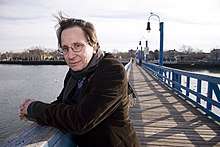
City Lore's Founder Dr. Steve Zeitlin has said that City Lore has: an "open mission to document and present New York City and America's living cultural heritage. Living cultural heritage used by folklorists to suggest the documentation, interpretation, and presentation of traditions within living memory, as opposed to events that predate living memory, and are, in a sense, purely historical. The original impetus for the discipline of folklore in the 19th century was the notion of collecting myths and legends as "survivals" from an earlier age, but City Lore is very present oriented. It's not only about capturing the past, it's about using an arts perspective to look at life itself. And to see the present in a slightly more vivid and interested and compelling way by looking at the artistic impulse in everyday life. Folklorists distinguish themselves from historians and from cultural anthropologists, because of the attention they pay to the aesthetic dimensions of history and culture."[2]
According to Zeitlin, City Lore is “tradition inspired but not tradition bound, and we are all about the redemptive power of grassroots creativity." Working across so many arenas of life, the organization has been described as a “full court press” on what became the tag line for the organization: the art of everyday life.
In a formal evaluation by the Artography initiative of Leveraging Investments in Creativity (LINC) funded by the Ford Foundation, Dr. William Westerman writes:
"It’s hard to understand what City Lore does in terms of art-making without first understanding how folklorists think of the concept of art. It is as if in Western society what is seen as the arts is equivalent to the visible light in the spectrum, whereas folklorists see the art across the whole spectrum, from ultraviolet to infrared. That full range of creative expression is what concerns the mission of City Lore, and it includes history and memory, language and religion, food and gardens, lace and place."[4]
The difference between City Lore and other arts programs is not simply that the arts presented are folk and traditional arts, but that City Lore’s arts are traditional and modern, and a great deal of the artmaking takes place in the collaborations of different cultural organizations and artists, and in the ties between the traditional and the way that contemporary New Yorkers use and adapt their traditions in their current work, whether they are professionals or schoolchildren. In this way, musical and poetic forms that build on traditional genres – including hip-hop, mambo,and spoken word – are part of a continuum of artistic practice that recognizes and builds upon deep genealogical connections to the past without being bound by them. It is in this way that City Lore’s work gets far beyond nostalgia, because the thrust is always forward-looking, not referring to what once was and could never be again, but building creatively with respect for the cultural foundations that exist."[3]
Programs and Series
City Lore works in four cultural domains: urban folklore and history, preservation, arts in education, and grassroots poetry traditions. In addition, City Lore undertakes special projects in keeping with its mission, and serves as a fiscal sponsor for filmmakers and other cultural specialists.
Urban folklore
The City Lore archives at 56 E. First Street on the Lower East Side houses 12,685 images by photographer Martha Cooper and 5,634 by Katrina Thomas. The total with other photographers was 19,320 images. The archive also includes 5,210 photographic negatives, 692 cassette tapes, 143 dat tapes, 163 mini DV tapes and 148 VHS tapes including oral histories, and traditional music and poetry performance tapes.[4] City Lore has over 800 digital video clips highlighting urban folklore subjects. Described as a “living archive,” the repository comes alive as it serves to inspire new public programs and continued documentation.
City Lore is a pioneer in cultural story mapping. In 2008, it launched City of Memory (cityofmemory.org), a story map of New York written about in the volume Letting Go: Sharing Authority in a User Generated World.[5] Designed with Flash technology by Local Projects, the map has been complemented with City Lore’s new Youtube based storymap designed by ESRI.
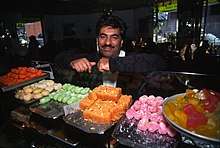
City Lore's People's Hall of Fame, established in 1993, honors grassroots contributions to New York's cultural life and presents winners with a plate-sized bronze version of the New York City subway token, representing a token of esteem. Recipients have included the Pearls of Wisdom Storytellers, Peter Benfaremo ("The Lemon Ice King of Corona"), Jim Power ("New York's Mosaic Man"),[6] and Renee Flowers (original member of the Gowanus Wildcats Girls Drill Team).[7] Honorees covered by The New York Times include the Harlem Blues and Jazz Band (1997),[6] the Bronx Old Timers Stickball League (1997),[7] and Tariq Hamad (1998),[8] founder of the first Indian sweet shop in New York.
In 2019, the People’s Hall of Fame honored Waterfront Heroes, local artists and activists working to preserve the New York Harbor including Naima Rauam for painting the poetry of the Fulton Fish Market; David Sharps, founder of the Waterfront Museum on a barge he personally dredged from the Hudson; Conrad Milster, a steam whistle collector from Brooklyn who started a 50-year New Year's Eve steam whistle blowing tradition in Brooklyn; and Samir Faraq, founder of Staten Island's Museum of Maritime Navigation & Communication and collector of forgotten maritime paraphernalia.

City Lore’s first urban folklore initiative was to document New York City street games. The City Play exhibit opened at the Museum of the City of New York in 1988, and the book, City Play was published by Rutgers University Press in 1992.[9] In 2016, City Lore and Public Art Films released Let’s Get the Rhythm: the Life and Times of Miss Mary Mack, directed by Irene Chagall, and coproduced by Steve Zeitlin and Irene Chagall. The New York Times writes “As it swings between games and interviews, “Let’s Get the Rhythm” has a beat; its incandescent musicality brings this hand-clapping universe to life.”[10]
In 1996, City Lore worked with activist Susie Tanenbaum and the Street Performers Advocacy Project to publish Know Your Rights! A Guide for Subway Performers pamphlet, now online, offering street performers the first look at their constitutional right to perform on subway platforms. The Guide has been in use by performers ever since.
Place Matters

In 1988, City Lore established the “Endangered Spaces” project to advocate for local establishments and landmarks that were disappearing from the New York City landscape.[11] In 1996, City Lore joined a new Task Force on Historical and Cultural Landmarks run by Ned Kaufman at the Municipal Art Society (MAS) and sponsored the conference “History Happened Here” at the Museum of the City of New York in 1998. Two years later, Place Matters was formally established by Ned Kaufman, Steve Zeitlin, and Marci Reaven, with Laura Hansen as the director. Based at City Lore, Place Matters aims to broaden the ways that preservation is understood and practiced by offering alternative ways of identifying, interpreting, celebrating, and ultimately protecting places that matter.[12]
In 2001, City Lore successfully nominated Bohemian Hall, still a vibrant community center/beer garden started by Czech immigrants in Astoria, Queens, the Casa Amadeo Music Store, the oldest, continuously occupied Latin music store in New York City, and the former Culyer Presbyterian Church, a center of Mohawk life in North Gowanus (Boerum Hill), as census sites to the National Register of Historic Places. Since then, there have been over 800 nominations from the public for City Lore’s Census of Places that Matter, including parks, historic sites, public art, bars, community gardens, industrial sites, and storefronts. In 2006, the Rutgers University Press published Hidden New York: A Guide to Places that Matter.[13] A year later, Place Matters, the Lower East Side Tenement Museum, and the Lower East Side Preservation Project presented the experiences of past and present Lower East Siders in a place-marking project called Your Guide to the Lower East Side. The initiative included twenty-eight signs at six separate sidewalk locations that featured photographs and text in five languages. These “place markers” weave personal stories and cherished memories directly into the landscape, often right where the stories took place. The signs reveal the rich and diverse layers of human experience that make the neighborhood so distinctive. They transform the participants' stories of struggle and achievement into a legacy for all who pass by.
Molly Garfinkel became the director of Place Matters in 2011, and, since then the program has expanded to include advocacy for community anchor sites across the nation, history-based public art projects in Baldwinsville, NY and greater Syracuse area, and policy-oriented campaigns around culturally-competent historic preservation protocols. Her 2019 essay Place Matters: Rooting Conservation in Community was published in the Journal of American Folklore.[14] Place Matters continues to welcome nominations to the Census of Places that Matter.
Arts in Education
Since 1986, City Lore has brought folk and community-based artists into New York City’s public schools reaching thousands of students each year students each year. Beginning as a partnership with Arts Connection, City Lore’s education program has grown to be a centerpiece of the organization’s work. In 2019-2020, the organization partnered with 15 schools to provide arts instruction for approximately 7,800 students in grades K-12 in a variety of art forms in the visual, literary, performing, and new media arts.[15] An early inspiration was an essay by Barbara Kirshenblatt-Gimblett, “An Accessible Aesthetic”:
A major factor in effective education is the integration of what is learned in the school with the experiences children have in their homes and communities. An equal challenge is the integration of the culture of the community into the curriculum. While we want our children to be exposed to a variety of art forms and cultures, we do not want them to be alienated for their birthright, their own heritage. And their own heritage is valuable, not only because it is their own, but also because of the importance of a strong indigenous culture to the coherence of community life.
City Lore’s teaching artists mirror the diversity of New York City’s public schools, and the organization works with partner schools `to customize arts residencies so that they relate the schools’ populations and integrate with their curricula. City Lore’s arts programs have brought Mexican, Ecuadorian, Egyptian, Ivorian, Cuban, Haitian, Peruvian, South African, and Brazilian artists into the schools.
Recent initiatives include:
- Roots, Routes, & Rhythms, an initiative that engages students in grades 3 through 8 from five Queens partner schools in exploring the roots of music and dance traditions in their boroughs and neighborhoods.
- From Homer to Hip Hop: Oral Traditions as a Gateway to Literature and Literacy, a new program which introduces students in grades 3 and 8 in two elementary and two middle schools in Queens to world poetry traditions, including sung poetry.
- Urban Explorers, a year-round after school program, including Saturdays and summer, that engages 26 youth in grades 6 to 12 in multi-media storytelling about and advocating for New York City’s grassroots cultures, while supporting their in-school education.
- KickFlip, an interest-driven, connected learning program implemented 2013-2015 designed to engage teen skateboarders and help them develop filmmaking, game design and coding skills to develop projects relating to their sport.
- City Lore’s education programs also have a national outreach. The organization helped organize a national conference in 1993 at the National Endowment for the Arts, and served as the sponsor and incubator for Local Learning: the National Network for Folk Arts in Education. City Lore cosponsored the newsletter CARTS (Cultural Arts Resources for Teachers and Students) Newsletter. City Lore contributes regularly to Local Learning's publication, Journal of Folk Arts in Education.
Grassroots Poetry
Poetry plays a key role in New York’s ethnic and cultural communities. For many immigrant communities, poetry is the most accessible and profound way for people to express themselves. Every community in New York City has its poets. City Lore is committed to finding ways to give these poets voice, finding the venues and formats for them to convey their artistry to their own communities and to the city at large, often finding new and innovative ways to communicate across languages.
City Lore was inspired to create the People’s Poetry initiative because, while some groups are dedicated to traditional music and many to literary poetry, no other organization was systematically presenting the diverse oral poetry traditions of New York City, the U.S. and beyond. The People’s Poetry Project grew out of the People’s Poetry Gathering, held in 1999, 2001, 2003 with Poets House, and in 2006 with Bowery Arts + Science, to bring together folk, ethnic, inner city, and literary poets. During these festivals in 1999, 2001, 2003, and 2006, Lower Manhattan was transformed into a poetry village for three days. The People’s Poetry Gathering was one of the highest profile poetry events in the United States and had an average audience of 10,000. In 2003, Poet Laureate, Billy Collins, wrote an insightful essay on the ballad for The New York Times on the festival’s opening day; and City Lore hosted a special conference and concert honoring Alan Lomax for his contribution to folk music and poetry. Beowulf and Sundiata were among the works featured.
In the aftermath of September 11, 2001 attacks, City Lore found and collected anonymous poems and other writings that had been left at memorials, hospitals and gathering places throughout the city. Through these actions, City Lore played a major role in documenting the shrines and memorials that cropped up after 9/11. A selection of these anonymous poems was published in the book, Words In Your Face: A Guided Tour Through Twenty Years of the New York City Poetry Slam.[16] and appeared in Steve Zeitlin's essay, "Oh Did You See the Ashes Come Thickly Falling Down.[17]
In 2006, the People’s Poetry Gathering featured poetry from the world’s endangered languages. This inspired Bob Holman and Steve Zeitlin to begin work on a tribute to the world’s endangered languages, a world “cento” (stitched together) poem in which each line came from a different endangered language. In 2013, the Festival of American Folklife in Washington DC hosted Khonsay: Poem of Many Tongues as an exhibit. The poem and subsequent film with Bob Holman would go on to serve as the subject of a tribute and call to action to preserve the worlds endangered languages, which premiered at the Margaret Meade Film Festival, and can be viewed online with extensive background information and a call for language preservation.
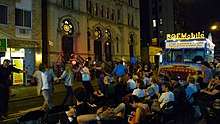
In 2010, City Lore and Bowery Arts + Science received a grant from the Rockefeller Foundation to launch the POEMobile that projects poems onto walls and building in tandem with live readings in New York City Neighborhoods. The POEMobile has traveled to Persian, Greek, Portuguese, Haitian, Dominican, Korean, as well as Yiddish-speaking neighborhoods, and also performed work with youth poets from Urban Word. In 2018, the POEMobile projected poems on to the steam rising up from New York City manholes to express the evanescence of life.
Urban Music and Dance
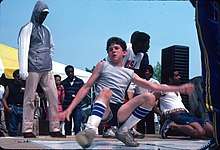
Prior to its founding in 1986, City Lore’s predecessor, the New York City Chapter of the New York Folklore Society sponsored "Music from the Islands: Puerto Rico, Cuba, and New York" at El Museo de Barrio, initiating a longstanding commitment to Latino music traditions. City Lore served as first fiscal sponsor for Puerto Rican Bomba and Plena band, Los Pleneros de la 21, whose director Juan Gutiérrez won a National Heritage Award from the National Endowment for the Arts in 1996.
In 2006, City Lore completed the documentary film From Mambo to Hip Hop, which won an Alma Award for Best Documentary that same year. In 2016, the organization sponsored Mathew Rodriguez Warrens’ doc, We Like It Like That: the Story of Latin Boogaloo. Elena Martinez coproduced both films, and was tapped by WHEDco (Women’s Housing and Urban Development) to spearhead along with Grammy-nominated bandleader Bobby Sanabria, the Bronx Music Heritage Lab and the new cultural center, The Bronx Music Heritage Center, opening in 2020.
In 1995, City Lore, working with folklorist Ray Allen, completed the Grassroots Gospel Initiative, recording acapella gospel quartet music in the borough's and releasing an LP. In 2006, Funds were raised by City Lore to support Peter Siegel's project to restore and issue tapes he made in the 1960s of folk music concerts by Mississippi John Hurt, The Carter Family, Jesse Fuller, Bill Monroe, and others. The recordings became the box set Friends of Old Time Music released by Smithsonian Folkways. [10] The box set was named one of the 10 best box sets of 2006 by The New York Times.
Urban Culture Exhibitions
Beginning with the opening of the exhibit City Play at the Museum of the City of New York (MCNY) in 1988, City Lore has developed public exhibitions about New York City – and America’s – folk culture. In 1993, City Lore curated the exhibit Welcome to Your Second Home: New York City’s Ethnic Social Clubs at MCNY.
In 2002, City Lore researched and curated Missing: Streetscape of a City in Mourning about the shrines and memorials that cropped up on New York City Streets after September 11. In 2005, City Lore developed the traveling exhibit and accompanying book, Weavings of War: Fabrics of Memory which featured the work of women textile artists from Central Asia, Southeast Asia, Latin America, and South Africa featured at The Puffin Gallery.[18] In 2012, City Lore curated the outdoor exhibit, Your Guide to the Lower East Side.
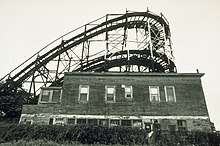
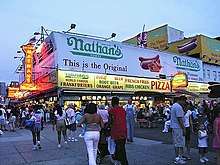
In 1988, City Lore presented oral histories of Coney Island on the boardwalk. In 1991, folklorist Steve Zeitlin suggested to Dick Zigun at Coney Island USA that, rather than trying performance art, they should bring a traditional old time sideshow, which Zeitlin had brought to the Smithsonian’s Folklife Festival a few years earlier, to Coney. The sideshow has run continuously to this day.[19] In 2017, City Lore presented the exhibit Boardwalk Renaissance: How the Arts Saved Coney Island.
In 2014, City Lore opened its own storefront gallery at 56 E. First Street. Exhibits have included Mother Tongues: Endangered Languages Spoken in New York City and Beyond (2015); What We Bring: New Immigrant Gifts (2018); and Bama and Pistol: Pioneers of Subway Graffiti (2019). In 2017, City Lore and Poets House curated the traveling exhibit Poetic Voices of the Muslim World, that travelled to public libraries in 12 cities
Special projects
City Lore produces documentary films and collaborates with filmmakers whose work relates to the organization's mission. Award-winning films include Ric Burns' Coney Island and the five-part series New York: A Documentary Film; City of Dreams, a film about women artists in New York City; From Mambo to Hip Hop,[11] a documentary which traces the history of music in the South Bronx; and DeAf Jam, which highlights the poetry and storytelling of the deaf performed in American Sign Language.
In 2017, City Lore teamed up with the Nurse Practitioner Healthcare Foundation is Seattle to create From Heritage to Health: An Art–Centered Approach to Cultural Competence (H2H), a multi-year project that highlights the ways in which storytelling and the arts can inform the diverse practices of medical professionals. H2H includes a learner needs assessment, public and professional presentations, eLearning courses, and other forms of educational outreach that enhance cultural competency in healthcare.
In 2019, City Lore became host to American Lore Theater and premiered the original play Salt Water People about the Bonacker Baymen of Long Island.[20]
Notable works and awards
In 2002, City Lore successfully nominated three cultural heritage sites from under-recognized communities to the National Register: Casa Amadeo Record Store, Bohemian Hall, and Cuyler Church used by the Mohawk community in Brooklyn.
On 2004, Mayor Michael R. Bloomberg officially proclaimed November 18 to be People's Hall of Fame Day in the City of New York, saying "In a city with 8 million stories to tell, some of the most fascinating tales are lost in the glorious din. Founded in 1986, City Lore is dedicated to amplifying the compelling but often unheard voices that make New York great. Through an engaging series of programs and publications, City Lore reveals the true richness of our cultural heritage. One of the organization’s signature events is the annual People's Hall of Fame Awards, which eschews the glare of popular celebrity in favor of the more luminescent glow of inspiration and integrity."[21] On Marcy 29, 2007, Mayor Bloomberg proclaimed another City Lore People's Hall of Fame Day in recognition of the tenth class of honorees.[22]
In 2007 City Lore’s Founder Steve Zeitlin was awarded the Benjamin Botkin Award by the American Folklore Society for lifetime achievement in public folklore; in 2019, City Lore’s Director of Arts in Education Amanda Dargan also received the award.
In 2016, City Lore received the Isidore Starr Award for excellence in from the National Council for the Social Studies and American Federation of Teachers. In 2009, City Lore’s arts education programs were highlighted in The Qualities of Quality: Understanding Excellence in Arts Education published by Harvard University’s Project Zero.
References
- American Folklore: An Encyclopedia. Brunvand, Jan Harold, ed. Garland Publishing, NY, 1996.
- Burton, Amber (2020-03-21). "Children, Parents and Teachers Get Creative in Time of Coronavirus". Wall Street Journal. ISSN 0099-9660. Retrieved 2020-03-22.
- Back, A. (2002-10-01). "The Folklorist As "Cultural Activist": An Interview with Steve Zeitlin". Radical History Review. 2002 (84): 124–136. doi:10.1215/01636545-2002-84-124. ISSN 0163-6545. S2CID 145350012.
- "City Lore - LINC". www.gateway.lincnet.net. Retrieved 2020-02-04.
- Lubar, Steven (April 2012). "Letting Go? Sharing Historical Authority in a User-Generated World". Curator: The Museum Journal. 55 (2): 233–236. doi:10.1111/j.2151-6952.2012.00143.x. ISSN 0011-3069.
- Gonzalez, David (1997-05-07). "Overdue Fame For Preserving That Rhythm". The New York Times. ISSN 0362-4331. Retrieved 2020-02-04.
- Alvarez, Lizette (1997-05-25). "The Asphalt Diamond". The New York Times. ISSN 0362-4331. Retrieved 2020-02-04.
- Weir, Richard (1998-11-29). "NEIGHBORHOOD REPORT: JACKSON HEIGHTS; Candy and a Taste of Home". The New York Times. ISSN 0362-4331. Retrieved 2020-02-04.
- Dargan, Amanda, 1950- (1990). City play. Zeitlin, Steven J. New Brunswick: Rutgers University Press. ISBN 0-8135-1577-7. OCLC 21041502.CS1 maint: multiple names: authors list (link)
- Reiss, Aaron; Rhyne, Emily; Heisler, Todd (2019-12-06). "Around the World in 5 Kids' Games". The New York Times. ISSN 0362-4331. Retrieved 2020-02-04.
- Kolbert, Elizabeth (1988-03-28). "Street Life: Keeping 'Beloved Places'". The New York Times. ISSN 0362-4331. Retrieved 2020-02-04.
- "Place Matters | Identify, Promote, Protect". Retrieved 2020-02-04.
- Reaven, Marci, 1954- (2006). Hidden New York : a guide to places that matter. Zeitlin, Steven J. New Brunswick, N.J.: Rivergate Books, an imprint of Rutgers University Press. ISBN 978-0-8135-4124-2. OCLC 191953101.CS1 maint: multiple names: authors list (link)
- Garfinkel (2019). "Place Matters: Rooting Conservation in Community". The Journal of American Folklore. 132 (526): 412–430. doi:10.5406/jamerfolk.132.526.0412. JSTOR 10.5406/jamerfolk.132.526.0412. S2CID 204482322.
- "Videos". City Lore. 2012-03-20. Retrieved 2020-02-04.
- Aptowicz, Cristin O'Keefe. (2008). Words in your face : a guided tour through twenty years of the New York City Poetry Slam. New York: Soft Skull. ISBN 978-1-933368-82-5. OCLC 165956969.
- Zeitlin, Steve (2006), "Oh Did You See the Ashes Come Thickly Falling Down? Poems Posted in the Wake of September 11", Spontaneous Shrines and the Public Memorialization of Death, Palgrave Macmillan US, pp. 99–117, doi:10.1007/978-1-137-12021-2_6, ISBN 978-1-349-73485-6
- Welsh, Mary Sue (2017-04-20). "War Stories". University of Illinois Press. 1. doi:10.5406/illinois/9780252037368.003.0015.
- Denson, Charles. (2002). Coney Island : lost and found. Ten Speed Press. p. 233. ISBN 1-58008-455-9. OCLC 50253166.
- Passy, Charles (2019-06-20). "New Play Looks at 'Bonacker' Fishermen of Long Island". Wall Street Journal. ISSN 0099-9660. Retrieved 2020-02-04.
- Proclamation, Office of the Mayor, Michael R. Bloomberg, November 18, 2004
- Proclamation, Office of the Mayor, Michael R. Bloomberg, March 29, 2007